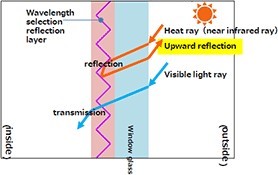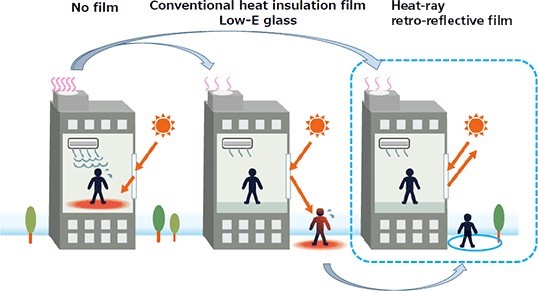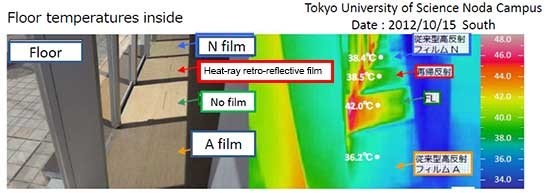Our heat-ray retro-reflective film reflects heat rays that come from high sun angles back into the sky rather than reflecting them down to the ground. By reflecting high-angle solar heat rays back to the sky, the heat-ray retroreflective film helps minimizes any heat rays reflected at neighboring structures, which in turn could help alleviate heating of the ground around a building. Therefore, it is expected that this film will minimize the heat island effect with proper usage. In tests using the heat-ray retro-reflective film, SAT (sol-air temperature, an adjusted outside air temperature reading) was approximately 10% lower than that produced even by Low-E glass.
Transmission of visible light to a building’s interior is about 70%. The heat-ray retro-reflective film offers shading equivalent to conventional heat shading films (60% heat gain coefficient), and insulates against 99% of ultraviolet, thus protecting interior fabrics and other materials against deterioration and sun-fading. The heat-ray retro-reflective film uses saw-toothed prisms (shown in cross-section) to create two reflections and bounce heat rays from high sun angles back to the sky. The film solution can be applied to the back of a single pane of glass or incorporated as part of a multiple pane-and-film structure. Other translucent architectural exterior elements can also benefit from it to damp unwanted reflectivity.

Note on “retro-reflective”: Retro-reflective as used here does not necessarily mean that the heat ray goes back in the direction of the sun. Although the reflective heatray goes back to the sky (with the same vertical a
ngle), horizontal reflection will be in other directions, as normal. For example, if a building window faces due south, in the morning, the heat rays come from the southeast and the reflective ray goes to the southwest.
Benefits Summary
o Help alleviate ground heating around a building by 10% more even than LowE glass. The heat-ray retro-reflective film currently is the only solution to heat caused by window reflection. o Reflects incoming high-angle heat rays back to the sky, not down to the ground. Low-angle heat rays (at dawn and sunset for example) pose much less of a heating problem. o Allows natural light into an interior in a natural spectral band so that colors can be perceived properly. o Offers a shading effect equivalent to conventional heat shading films, thus keeping heat out in the summer, saving energy. o May be retrofitted or incorporated into a multiple pane window structure.
Development Summary
Ready for commercialization. Reflection and transmissivity tests have been conducted at the University of Tokyo.
Technology Benefits Description
As of this writing, the heat-ray retro-reflective film is the only solution to area ground heating caused by reflection from windows. (Other solutions exist for roofs and wall structures, although even these are not universally applicable.) Even Low-E glass windows and windows with insulating film reflect heat downwards to the ground level because of reflection from a high sun angle, where it combines with natural insolation (sunlight) to cause additional warming.

In addition to helping reduce heating around a building from reflected high-angle sunlight, the heat-ray retro reflective film saves cooling energy for buildings by insulating windows (thus keeping the sun’s heat out in summer).
The heat-ray retro-reflective film allows about 70% of the visible spectrum of light through the window to help reduce lighting load during daylight hours. It provides a light of a natural spectral balance for accurate color rendering.
Technology Differentiation and Uniqueness
Our heat-ray retro-reflective film uses saw-toothed prisms to reflect heat up and away from a building. Even Low-E glass and heat-insulating film reflect heat to the ground outside of a building. By reflecting high sun angle heat rays upward, the heat-ray retro-reflective film may help reduce situations where reflection from a building add to direct insolation make an area on the ground outside the building unpleasantly hot. In tests, the heat-ray retroreflective film resulted in a reduction in sol-air temperature about 10% lower than the reduction produced by LowE glass. (SAT is an outside air temperature adjusted to take into account the effect of solar heat reflection.)

Our heat-ray retro-reflective film transmits about 70% of visible light to the interior of a building, insulates against solar radiation heat at about the same level as conventional heat shading films to reduce heating and cooling costs (solar head gain coefficient 60%).
Development Status Summary
Ready for commercialization. Reflection and transmissivity tests have been conducted at the University of Tokyo.
Collaboration Description
We are looking for glass processing companies/distributors who can put our film between the pair glass for construction market.
Seller Support
Documentation, Personnel
